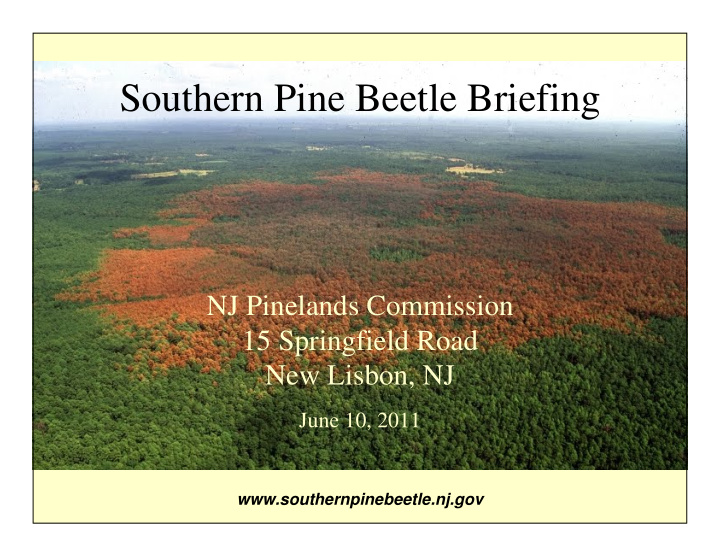



Southern Pine Beetle Briefing NJ Pinelands Commission 15 Springfield Road New Lisbon, NJ June 10, 2011 www.southernpinebeetle.nj.gov
History (Dendroctonus frontalis) • Active populations for decades in Southeastern U.S. • In 2001, a consultant forester reported an insect problem in NJ. • SPB identification was made by NJFS and USFS. • Likely migrated to NJ via wind and/or interstate commerce.
Source: NJ Forest Service 2010
SPB trapping program monitors SPB populations
2010 SPB General Movement Mullica 2009 River 2002 -2007 Egg Harbor River
Data and Mapping Digital Aerial Mapping Systems • GPS tracking over aerial imagery. • 85% of all suspected SPB infestations detected through aerial flights are confirmed through ground verification as SPB.
Large Aggressive Spots Multiple Heads March 22, 2011 Early during leaf out May 23, 2011 60 days later
Verification following aerial detection
Characteristic pitch tubes from adult Southern Pine Beetle attack
SPB Life Cycle Egg (1) Larva (2) Adult (3) Pupa (2) 1 Photo provided by the USFS 2 Photo provided by Bugwood.org 3 Photo provided by Gerald Lenhard
SPB Life History Multiple generations each year in same area Most of the larvae are SPB Adult (left), rice concealed within bark grain, turpentine beetle
S-shaped galleries and pupa chambers on the underside of infested bark
Indian Mounds Wilderness in Texas February 1993
SPB severe outbreak (Tennessee)
8 Years of SPB Mortality Approximately 389 recorded infestations (14,100 acres) in the NJ Pinelands region in 2010
Hardings Run Apartment Complex in Mays Landing
Winslow Wildlife Management Area
Glassboro Wildlife Management Area with feed strip
Union Lake Wildlife Management Area
Clarks Landing with Mullica River in background
Clarks Landing with Mullica River in background
Clarks Landing with Mullica River in background
Clarks Landing looking south past the Mullica River
Pine Plains…
Current Strategies • Aerial survey flights – Once a week • SPB spots detected and ground verified • Foresters prepare and submit a report • T&E species; Inter-agency review process • Coordinate with the Pinelands Commission • State certified sawyer crews scheduled to perform suppression activities (cut and leave) • Site is monitored after treatment via air and ground
SPB suppression activities by State Forest Fire Service certified sawyer crews.
Small Spot Treatment • Limited number of trees • Generally located around lightning strikes or stressed trees • Minimal environmental impact
Ad Hoc Advisory Committee • Emile DeVito - NJ Conservation Foundation • John Bunnell– Pinelands Commission • Kim Laidig - Pinelands Commission • Troy Ettel - NJ Audubon • George Zimmermann – Stockton College • Mark Vodak – Rutgers University • Matthew Ayres - Dartmouth College • Ronald Billings - Texas Forest Service • Bill Oldland - USFS • Stephen Clarke - USFS • James Meeker – USFS • Bob Williams - Land Dimensions • Mayor Pikolycky of Woodbine Borough • Thomas Bullock – NJ Forestry Association • Brad Rosenthal – Cape May County • Tom Hirshblond - Industry Representative • Matt Simons - Atlantic City Electric • Richard Reenstra – Ocean County • Ken Taaffe - NRCS • Roger Smith - Fort Dix
U. S. Forest Service Percent Mortality Projections 2006-2020
Impacts to the Pinelands • Rapid conversion of pine forests to hardwoods. • Loss of critical habitat for T & E species. • Watershed and riparian deterioration. • Loss of aesthetics and recreational opportunities. • Increased wildfire risk to lives and property. • Increased danger from hazard tree failure.
Critical Needs • Partnership with the Pinelands Commission for SPB suppression. • Temporary emergency action creating an expedited review and permitting process (five working days or less) for SPB cut and leave suppression activities.
Critical Needs • Meet with Pinelands Commission staff to develop a specific implementation and permitting process. • Monthly updates to the Pinelands Commission outlining suppression progress and beetle populations dynamics.
Recommend
More recommend